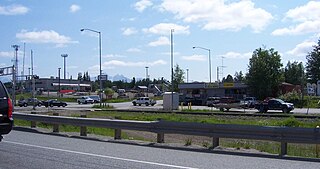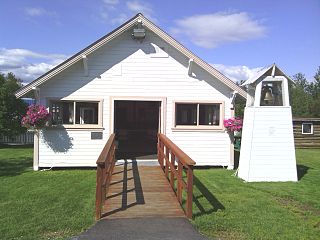
Matanuska-Susitna Borough is a borough located in the U.S. state of Alaska. Its borough seat is Palmer, and the largest community is the census-designated place of Knik-Fairview. As of the 2020 census, the borough's population was 107,801.
Joe Redington, Senior was an American dog musher and kennel owner, who is best known as the "Father of the Iditarod Trail Sled Dog Race", a long distance sled dog race run annually from the Anchorage area to Nome, Alaska.
Dorothy G. Page was best known as "Mother of the Iditarod Trail Sled Dog Race", the 1,049-mile dog sled race across the U.S. state of Alaska.

The Denaʼina, or formerly Tanaina, are an Alaska Native Athabaskan people. They are the original inhabitants of the south central Alaska region ranging from Seldovia in the south to Chickaloon in the northeast, Talkeetna in the north, Lime Village in the northwest and Pedro Bay in the southwest. The Denaʼina homeland is more than 41,000 square miles in area. They arrived in the south-central Alaska sometime between 1,000 and 1,500 years ago. They were the only Alaskan Athabaskan group to live on the coast. The Denaʼina have a hunter-gatherer culture and a matrilineal system. The Iditarod Trail's antecedents were the native trails of the Denaʼina and Deg Hitʼan Athabaskan Native Alaskans and the Inupiaq Inuit.

The Oscar Anderson House Museum is a historical museum at 420 M Street in downtown Anchorage in the U.S. state of Alaska. Located in Elderberry Park, the structure was built in 1915 by early Anchorage resident Oscar Anderson. Anderson claimed to be the 18th person to set foot on what is now Anchorage. The structure was the first wood-frame house in Anchorage, and was occupied by Anderson until his death in 1974. The house was completely restored to a 1915 appearance between 1978 and 1982, and is now open as a historic house museum.
Knik may refer to the following entities in Alaska:
The Wasilla Assembly of God is a Pentecostal church in the town of Wasilla, Alaska. It is affiliated with the Assemblies of God USA.

The City of Wasilla (Dena'ina: Benteh) is a city in Matanuska-Susitna Borough, United States and the fourth-largest city in Alaska. It is located on the northern point of Cook Inlet in the Matanuska-Susitna Valley of the southcentral part of the state. The city's population was 9,054 at the 2020 census, up from 7,831 in 2010. Wasilla is the largest city in the borough and a part of the Anchorage metropolitan area, which had an estimated population of 398,328 in 2020.

Old St. Nicholas Russian Orthodox Church, also known as the Eklutna Chapel, is a historic Russian Orthodox church in Eklutna, Alaska. It is about one mile inland from the Knik Arm of the Cook Inlet.

The Alaskan Engineering Commission (AEC) was a U.S. Federal agency, sometimes known by its initials or by alternate spelling Alaska Engineering Commission. It was created by the Alaska Railroad Act in 1914 by U.S. President Woodrow Wilson in order to arrange for the construction of a railway system in Alaska. William C. Edes was named chairman, chief engineer Colonel Frederick Mears. In 1915, the AEC became part of the U.S. Department of the Interior. In 1923, after the railroad began operation and construction was complete, it became the Alaska Railroad Commission, later renamed to The Alaska Railroad.

The Wasilla Depot was built in 1917 in Wasilla, Alaska. It was designed and built by the Alaska Engineering Commission, a federal agency charged with building Alaska's railways. The structure, located at the corner of Parks Highway and Main Street, was restored by the Lions Clubs and the Wasilla Chamber of Commerce.
The Whitney Section House, also known as Whitney Station, is a historic railroad-related building in Wasilla, Alaska. It is a single-story wood-frame structure, which was built in 1917 by the Alaska Railroad. It originally stood at mile 119.1, about 4.8 miles (7.7 km) north of Anchorage Station, and was one of a series built by the railroad and located at roughly ten-mile intervals. The area where it stood was taken by the federal government for Elmendorf Air Force Base, and was rescued from demolition by the local chapter of the National Railroad Historical Society. It now stands on the grounds of the Alaska Museum of Transportation and Industry in Wasilla, and has seen a variety of uses.

The Wasilla Elementary School, located near the corner of East Swanson Avenue and North Boundary Street in Wasilla, Alaska is a historic one-room school that was built in 1917. It was Wasilla's first school, and served as its primary school until 1934 when a larger school was built. It is 22 by 36 feet in dimension. It was moved to its present location, in a historic park, shortly before its NRHP nomination in 1979. It had been located about three blocks away. After 1934 it was used again as a school overflow classroom and it also served as a community hall and for weddings, funerals and other events; it served as a Church of Christ for a number of years.
The Wasilla Community Hall, also known as the Wasilla Museum, now hosting the Dorothy G. Page Museum, is located at 323 Main Street in Wasilla, Alaska. The museum is located in a log building constructed in 1931 to serve as a community center. The exterior of the building was left largely as-is when it was converted to a museum in 1967. The interior houses displays about the history of the city of Wasilla.

The Oscar Gill House is a historic house at 1344 West Tenth Avenue in the South Addition neighborhood of Anchorage, Alaska. It is one of Anchorage's oldest buildings. It is a two-story wood-frame structure, three bays wide, with a side gable roof. The bays are asymmetrically arranged, with a single-window bay on the right and a double-window bay on the left. The center bay is taken up by a projecting gable-roofed vestibule, in which the door is slightly off-center. The house's modest Craftsman style includes extended eaves with exposed rafter ends, and it has retained original interior flooring and woodwork. The house was built in 1913 by Oscar Gill in the town of Knik at the head of Knik Arm. When Anchorage was established in 1916, Gill had the house barged across the inlet, and it stood at 918 West Tenth Avenue for many decades. The house was removed from that site in 1982 to accommodate expansion of the Anchorage Pioneer Home, one of many historic houses throughout downtown Anchorage which fell victim to a real estate and building boom that intensified in 1982 and 1983. Unlike other similar structures, most of which spent years in storage on municipally-owned land but were eventually demolished, this house was spared. It sat on a vacant lot on P Street, across from the western end of the Delaney Park Strip, for approximately a decade and a half before being moved to its present location. The house has been operated as a bed and breakfast establishment since that time.

The Knik Site, also known as the Old Knik Townsite, is the location in Matanuska-Susitna Borough, Alaska that was once home to the largest settlement on Cook Inlet. The only surviving remnants of the community are a former log roadhouse, now a museum operated by the Wasilla-Knik Historical Society, and a log cabin. The Knik area had long been a meeting point of Native Alaskans, and in 1898 it became the principal community on Cook Inlet from which goods were shipped into the interior. In 1916 the Alaska Railroad reached the site of present-day Anchorage, bypassing Knik and leading to Anchorage's growth. When the railroad reached Wasilla, Knik lost all importance as a transshipment point, and its buildings were either abandoned or moved to one of the other communities. Knik is located about 13 miles (21 km) southwest of Wasilla.

Teeland's Country Store, also known as Herning's Place and Knik Trading Company, is a historic retail establishment located at the corner of East Herning Avenue and North Boundary Street in Wasilla, Alaska. The oldest portion of this wood-frame building is a log structure at the back whose construction dates to 1905. Originally located at Knik, this log structure, then also used as a store, was moved to the newly established town of Wasilla in 1917 by its builder, O. G. Herning. Herning also built the present utilitarian wood-frame structure, which still operates today. The business was purchased by Walter Teeland in 1947, giving it its present name. In 1972 the store was purchased by Jules and Leslie Mead and Neil Gail Bridgewater.

Cunningham-Hall PT-6 NC692W is one of two surviving aircraft of its type from the early days of aviation in the history of Alaska. The Cunningham-Hall PT-6 is a single-engine six-seat cabin biplane built by the Cunningham-Hall Aircraft Corporation, which was designed mainly as a personal transport. The aircraft, registered as NC692W, with c/n. 2962, was built in 1930 and is the second of its kind constructed. It was entirely rebuilt as a static display using non-airworthy materials in the 1970s.
















